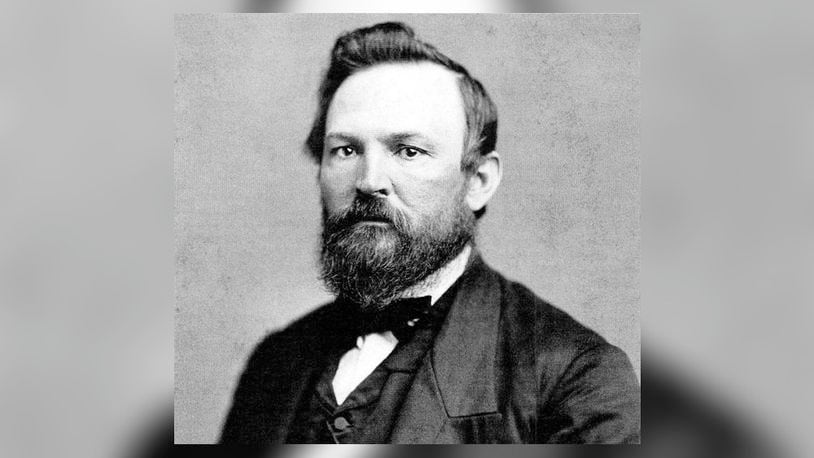Furnas was born on a farm near Troy in Miami County.
His father, William Furnas, and his mother, Martha Jenkins, died of cholera within a few days of each other in 1832, when Robert was just 8 years old.
Raised by his grandfather, Thomas Furnas, Robert became a “chore boy” at age 12 in the Singer & Brown general store in Troy.
At age 14, Robert was apprenticed in the tinsmith trade with I.W. Hart in Troy. Then, at 18, he was again apprenticed, this time to Rich Langdon of the Licking Valley Register in Covington, Ky., where he served a full four year term, learning the art of printing.
After his apprenticeships, Robert took a job with A.G. Sparhawk, a book publishing house in Cincinnati.
During this time he married Mary McComas, with whom he had eight children.
Return to Troy
In 1846, Furnas returned to Troy where he purchased and published the “Times” newspaper.
After a few years, Furnas stepped away from the newspaper business and went to work in the clock, watch and jewelry business.
He also took on appointments as village clerk and deputy postmaster.
When the Dayton and Michigan railroad to Troy was completed, Furnas started working for the train company, becoming a railroad and express agent as well as a conductor.
Move to Nebraska
In 1856, Furnas moved his family to farm in Brownville, Nebraska. He brought along a printing press and again entered the newspaper business, starting the Nebraska Advertiser.
Then in 1868, he launched the Nebraska Farmer, the first agricultural newspaper in the state.
His 100-acre fruit farm where he grew both vines and trees was thought to be marvel to behold, according to newspaper reports from the time.
Civil War years
At the start of the Civil War, Furnas was commissioned as a brigadier general in service to the district south of the Platte river.
He was then appointed and commissioned by President Abraham Lincoln on March 22, 1862, as a colonel in the Army.
Under this commission, he organized and commanded three Native American regiments composed of Creeks, Seminoles, Choctaw, Chickasaw and Cherokee.
With these regiments Furnas fought several successful battles against Confederate soldiers on the border of the Missouri River.
After his military service, Furnas was appointed by Lincoln as agent for the Omaha Indians, a post he served in for four years.
In that role, Furnas helped elevate the Omaha tribe agriculturally, to the point they were producing and selling 40,000 bushels of surplus corn annually.
Nebraska legislator
After being removed from his post as agent, Furnas returned to his farm in Brownville in 1868.
That same year, he was elected to the council branch of the Nebraska legislature, on which he served four years. One of his roles was as public printer, which led to him printing laws and journals for the government.
He then began writing for the legislature, authoring the first common school law for Nebraska. He also wrote the law creating what became the State Board of Agriculture.
Governor
In 1873, Furnas was elected as the second governor of the State of Nebraska.
Furnas was elected by a large majority but only served one term. The duties of the job, and the politics involved, were not to his liking.
Furnas held many other official positions in Nebraska, including president and secretary of the State Board of Agriculture, president and secretary of the State Horticultural Society, president of the state Historical Society, president of the Nebraska Soldier’s Union, vice president of the American Pomological Society, president of American Fair and Expositions and more.
Arbor Day
On Jan. 4, 1872, Legislator J. Sterling Morton introduced and the Nebraska state board of agriculture passed a resolution urging the people of that state to plant trees on April 10 of that year. An estimated 1 million trees were planted that day in what is considered the first American Arbor Day.
The people of Nebraska voluntarily observed Arbor Day again in 1873.
In 1874, Gov. Furnas made an official proclamation and recommended that people again observe Arbor Day and to petition the state legislature to make it a legal holiday.
Over the next 11 years the people of Nebraska celebrated Arbor Day with increasing interest.
It was not until 1885 that the legislature took official action, making April 22 a legal holiday.
By this time other states had followed Nebraska’s example of observing Arbor Day and petitions to their legislatures got ahead of Nebraska in officially making it a legal holiday.
Furnas said in 1894, “Since the inauguration of the day in this state it has been instrumental in planting trees in our naturally treeless prairies, numbering into the billions. Nearly all the states in the Union have adopted it ... The work of tree planting, inspired by the existence of Arbor day, is simply wonderful.”
By the 1920s, each state in the United States had passed public laws that stipulated a certain day to be Arbor Day.
Today, National Arbor Day is celebrated yearly by every state, with the most common date falling on the last Friday in April. Some states have made adjustments to coincide with the best tree planting weather.
About the Author
